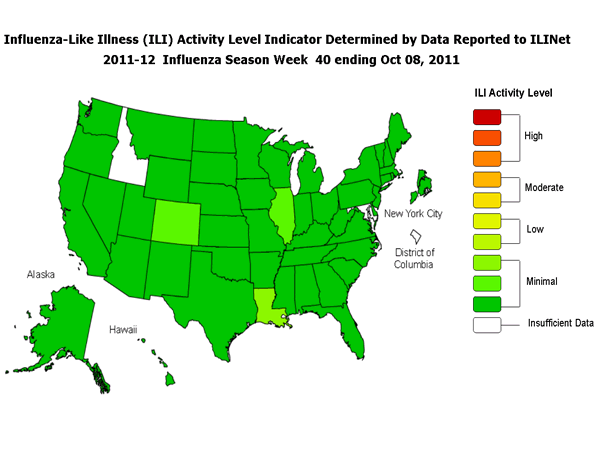Error processing SSI file

2011-2012 Influenza Season Week 40 ending October 8, 2011
All data are preliminary and may change as more reports are received.
Background:
The Centers for Disease Control and Prevention’s (CDC) Influenza Division collects and analyzes surveillance data year-round and produces a weekly report on U.S. influenza activity from October through May. The U.S. influenza surveillance system consists of information in five categories collected from eight data sources.
This report summarizes influenza activity during the summer weeks of the 2010-11 season and is also the first report of the 2011-12 influenza season which began on October 2, 2011.
The five categories of influenza surveillance consist of:
- Viral Surveillance: U.S. World Health Organization (WHO) collaborating laboratories, the National Respiratory and Enteric Virus Surveillance System (NREVSS), and human infection with novel influenza A virus case reporting;
- Outpatient Illness Surveillance: U.S. Outpatient Influenza-like Illness Surveillance Network (ILINet);
- Mortality: 122 Cities Mortality Reporting System and influenza-associated pediatric mortality;
- Hospitalizations: Influenza Hospitalization Network (FluSurv-NET) including the Emerging Infections Program (EIP),
- Summary of geographic spread of influenza: state and territorial epidemiologists’ reports.
An overview of surveillance methods is available at: http://www.cy118119.com/flu/weekly/overview.htm
Synopsis:
During week 40 (October 2-8, 2011), influenza activity was low in the United States.
- Viral Surveillance: Of the 1,343 specimens tested by U.S. World Health Organization (WHO) and National Respiratory and Enteric Virus Surveillance System (NREVSS) collaborating laboratories and reported to CDC/Influenza Division, 16 (1.2%) were positive for influenza.
- Pneumonia and Influenza Mortality: The proportion of deaths attributed to pneumonia and influenza (P&I) was below the epidemic threshold.
- Influenza-associated Pediatric Deaths: No influenza-associated pediatric deaths were reported
- Outpatient Illness Surveillance: The proportion of outpatient visits for influenza-like illness (ILI) was 1.0%, which is above the national baseline of 2.4%. All 10 regions reported ILI below region-specific baseline levels. Forty-eight states and New York City experienced minimal ILI activity and the District of Columbia and two states had insufficient data.
- Geographic Spread of Influenza: The geographic spread of influenza in the District of Columbia, Puerto Rico, the U.S. Virgin Islands, and 20 states was reported as sporadic; Guam and 29 states reported no influenza activity, and one state did not report.
| HHS Surveillance Regions* | Data for week 40 (October 2-8, 2011) | |||||||
|---|---|---|---|---|---|---|---|---|
| Out-patient ILI† | % positive for flu‡ | Number of jurisdictions reporting regional or widespread activity§ | A (H3) | 2009 A (H1N1) | A(Subtyping not performed) | B | Pediatric Deaths | |
| Nation | Normal | 1.2% | 0 of 54 | 1 | 7 | 7 | 1 | 0 |
| Region 1 | Normal | 0.0% | 0 of 6 | 0 | 0 | 0 | 0 | 0 |
| Region 2 | Normal | 0.0% | 0 of 4 | 0 | 0 | 0 | 0 | 0 |
| Region 3 | Normal | 0.5% | 0 of 6 | 0 | 0 | 1 | 0 | 0 |
| Region 4 | Normal | 2.1% | 0 of 8 | 0 | 0 | 5 | 0 | 0 |
| Region 5 | Normal | 3.7% | 0 of 6 | 1 | 2 | 0 | 1 | 0 |
| Region 6 | Normal | 0.6% | 0 of 5 | 0 | 1 | 1 | 0 | 0 |
| Region 7 | Normal | 0.0% | 0 of 4 | 0 | 0 | 0 | 0 | 0 |
| Region 8 | Normal | 1.1% | 0 of 6 | 0 | 2 | 0 | 0 | 0 |
| Region 9 | Normal | 0.0% | 0 of 5 | 0 | 0 | 0 | 0 | 0 |
| Region 10 | Normal | 12.5% | 0 of 4 | 0 | 2 | 0 | 0 | 0 |
*HHS regions (Region 1 CT, ME, MA, NH, RI, VT; Region 2: NJ, NY, Puerto Rico, US Virgin Islands; Region 3: DE, DC, MD, PA, VA, WV; Region 4: AL, FL, GA, KY, MS, NC, SC, TN; Region 5: IL, IN, MI, MN, OH, WI; Region 6: AR, LA, NM, OK, TX; Region 7: IA, KS, MO, NE; Region 8: CO, MT, ND, SD, UT, WY; Region 9: AZ, CA, Guam, HI, NV; and Region 10: AK, ID, OR, WA).
† Elevated means the % of visits for ILI is at or above the national or region-specific baseline
‡ National data are for current week; regional data are for the most recent three weeks
§ Includes all 50 states, the District of Columbia, Guam, Puerto Rico, and U.S. Virgin Islands
U.S. Virologic Surveillance:
WHO and NREVSS collaborating laboratories located in all 50 states and Washington D.C. report to CDC the number of respiratory specimens tested for influenza and the number positive by influenza type and subtype. The results of tests performed during the current week are summarized in the table below.
| Week 40 | |
|---|---|
| No. of specimens tested | 1,343 |
| No. of positive specimens (%) | 16 (1.2%) |
| Positive specimens by type/subtype | |
| Influenza A | 15 (93.8%) |
| A (2009 H1N1) | 1 (6.7%) |
| A (subtyping not performed) | 7 (46.7%) |
| A (H3) | 7 (46.7%) |
| Influenza B | 1 (6.2%) |
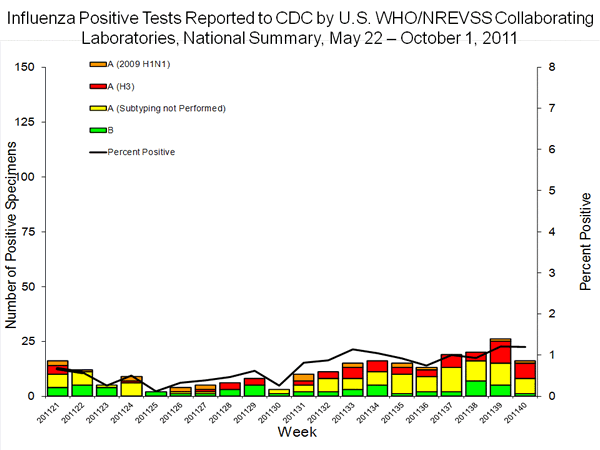
View National and Regional Level Graphs and Data | View Chart Data | View Full Screen | View PowerPoint Presentation
Antigenic Characterization:
Isolates from 21 specimens collected in the United States between May 22 and September 30, 2011 were available for antigenic characterization, including two 2009 influenza A (H1N1), 12 influenza A (H3N2), and seven influenza B viruses.
Both 2009 influenza A (H1N1) viruses were closely related antigenically to the influenza A (H1N1) component of the 2011-12 influenza vaccine (A/California/7/2009-like); all 12 of the influenza A (H3N2) viruses tested were closely related antigenically to the influenza A (H3N2) component of the vaccine (A/Perth/16/2009-like).
Influenza B viruses currently circulating globally can be divided into two distinct lineages represented by the B/Yamagata/16/88 and B/Victoria/02/87 viruses. Of the seven influenza B viruses tested, six (86%) belonged to the Victoria-lineage and were closely related antigenically to the influenza B component of the 2011-12 influenza vaccine (B/Brisbane/60/2008-like). One of 12 (14%) influenza B viruses tested belonged to the Yamagata-lineage.
Novel Influenza A Viruses:
Four human infections with novel influenza A viruses were detected in children from two states (Indiana (1) and Pennsylvania (3)). All four children were infected with swine-origin influenza A (H3N2) viruses; two were hospitalized; all four have since recovered from their illness. The case in Indiana did not report exposure to pigs prior to illness onset, although an epidemiologic investigation concluded human to human transmission was likely as a close contact reported direct contact with pigs prior to the child’s illness onset. The three cases in Pennsylvania were associated with attendance at a local fair where swine were exhibited. No sustained human-to-human transmission of these viruses was found in either state. Additional information on these cases can be found at http://www.cy118119.com/mmwr/preview/mmwrhtml/mm6035a6.htm?s_cid=mm6035a6_w and http://www.cy118119.com/media/haveyouheard/stories/lab_testing.html
Early identification and investigation of human infections with novel influenza A viruses is critical to evaluate the extent of the outbreak and possible human-to-human transmission. Additional information on influenza in pigs and swine-origin influenza infection in humans can be found at http://www.cy118119.com/flu/swineflu/
Antiviral Resistance:
Testing of 2009 influenza A (H1N1), influenza A (H3N2), and influenza B virus isolates for resistance to neuraminidase inhibitors (oseltamivir and zanamivir) is performed at CDC using a functional assay. Additional 2009 influenza A (H1N1) clinical samples are tested for a single known mutation in the neuraminidase of the virus that confers oseltamivir resistance (H275Y). The data summarized below combine the results of both test methods. These samples are routinely obtained for surveillance purposes rather than for diagnostic testing of patients with suspected antiviral resistance.
High levels of resistance to the adamantanes (amantadine and rimantadine) persist among 2009 influenza A (H1N1) and A (H3N2) viruses (the adamantanes are not effective against influenza B viruses). As a result of the sustained high levels of resistance, data from adamantane resistance testing are not presented in the table below.
| Virus Samples tested (n) |
Resistant Viruses, Number (%) Oseltamivir |
Virus Samples tested (n) |
Resistant Viruses, Number (%) Zanamivir |
|
|---|---|---|---|---|
| Influenza A (H3N2) | 15 | 0 (0.0) | 15 | 0 (0.0) |
| Influenza B | 7 | 0 (0.0) | 7 | 0 (0.0) |
| 2009 Influenza A (H1N1) | 3 | 0 (0.0) | 3 | 0 (0.0) |
Antiviral treatment with oseltamivir or zanamivir is recommended as early as possible for patients with confirmed or suspected influenza who have severe, complicated, or progressive illness; who require hospitalization; or who are at greater risk for influenza-related complications. Additional information on recommendations for treatment and chemoprophylaxis of influenza virus infection with antiviral agents is available at http://www.cy118119.com/flu/antivirals/index.htm.
The majority of currently circulating influenza viruses are susceptible to the neuraminidase inhibitor antiviral medications oseltamivir and zanamivir; however, rare sporadic cases of oseltamivir resistant 2009 influenza A (H1N1) and A (H3N2) viruses have been detected worldwide. To prevent the spread of antiviral resistant virus strains, CDC reminds clinicians and the public of the need to continue hand and cough hygiene measures for the duration of any symptoms of influenza, even while taking antiviral medications (http://www.cy118119.com/mmwr/preview/mmwrhtml/mm5832a3.htm).
Pneumonia and Influenza (P&I) Mortality Surveillance
During week 40, 6.0% of all deaths reported through the 122 Cities Mortality Reporting System were due to P&I. This percentage was below the epidemic threshold of 6.5% for week 40.
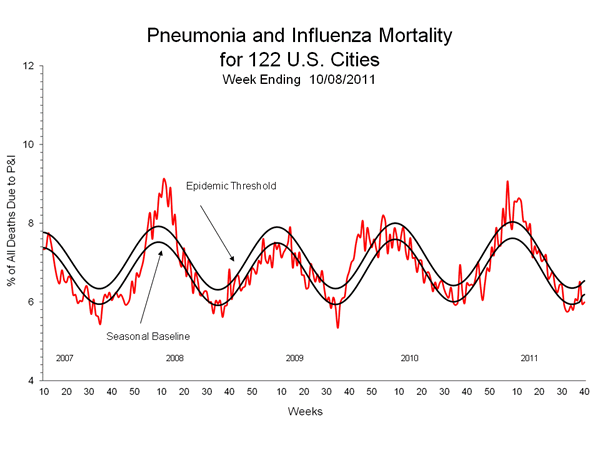
View Full Screen | View PowerPoint Presentation
Influenza-Associated Pediatric Mortality
No influenza-associated pediatric deaths were reported to CDC during week 40. However, one death 2011occurred during the summer weeks of the 2010-11 season and was associated with an influenza B virus.
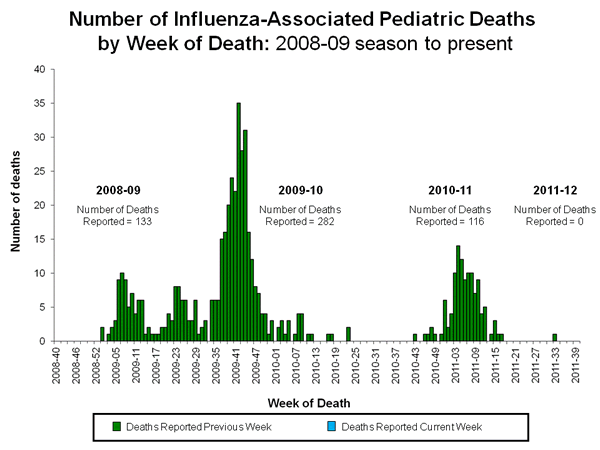
View Full Screen | View PowerPoint Presentation
Influenza-Associated Hospitalizations
The Influenza Hospitalization Network (FluSurv-NET) conducts population-based surveillance for laboratory-confirmed influenza related hospitalizations in children (persons younger than 18 years) and adults. The network covers more than 80 counties in the 10 Emerging Infections Program (EIP) states (CA, CO, CT, GA, MD, MN, NM, NY, OR, and TN) and four additional states (MI, OH, RI and UT). FluSurv-NET estimated hospitalization rates will be updated weekly starting later this season.
Outpatient Illness Surveillance:
Nationwide during week 40, 1.0% of patient visits reported through the U.S. Outpatient Influenza-like Illness Surveillance Network (ILINet) were due to influenza-like illness (ILI). This percentage is below the national baseline of 2.4%. (ILI is defined as fever (temperature of 100°F [37.8°C] or greater) and cough and/or sore throat.)
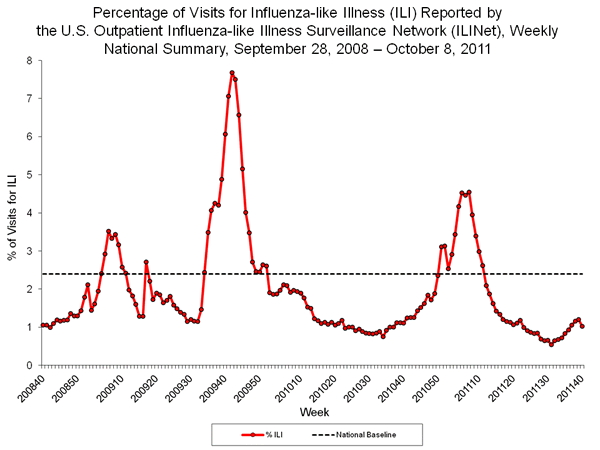
View National and Regional Level Graphs and Data | View Chart Data | View Full Screen | View PowerPoint Presentation
On a regional level, the percentage of outpatient visits for ILI ranged from 0.4% to 2.0% during week 40. All 10 regions reported a proportion of outpatient visits for ILI below their region-specific baseline levels.
ILINet State Activity Indicator Map:
Data collected in ILINet are used to produce a measure of ILI activity* by state. Activity levels are based on the percent of outpatient visits in a state due to ILI and are compared to the average percent of ILI visits that occur during spring and fall weeks with little or no influenza virus circulation. Activity levels range from minimal, which would correspond to ILI activity from outpatient clinics being below the average, to intense, which would correspond to ILI activity from outpatient clinics being much higher than average.
During week 40, the following ILI activity levels were experienced:
- Forty-eight states and New York City experienced minimal ILI activity (Alabama, Alaska, Arizona, Arkansas, California, Colorado, Connecticut, Delaware, Florida, Georgia, Hawaii, Illinois, Indiana, Iowa, Kansas, Kentucky, Louisiana, Maine, Massachusetts, Michigan, Minnesota, Mississippi, Missouri, Montana, Nebraska, Nevada, New Hampshire, New Jersey, New Mexico, New York, North Carolina, North Dakota, Ohio, Oklahoma, Oregon, Pennsylvania, Rhode Island, South Carolina, South Dakota, Tennessee, Texas, Utah, Vermont, Virginia, Washington, West Virginia, Wisconsin, and Wyoming).
- Data were insufficient to calculate an ILI activity level from the District of Columbia and two states (Idaho and Maryland).
*This map uses the proportion of outpatient visits to health care providers for influenza-like illness to measure the ILI activity level within a state. It does not, however, measure the extent of geographic spread of flu within a state. Therefore, outbreaks occurring in a single city could cause the state to display high activity levels.
Data collected in ILINet may disproportionately represent certain populations within a state, and therefore, may not accurately depict the full picture of influenza activity for the whole state.
Data displayed in this map are based on data collected in ILINet, whereas the State and Territorial flu activity map are based on reports from state and territorial epidemiologists. The data presented in this map is preliminary and may change as more data is received.
Differences in the data presented here by CDC and independently by some state health departments likely represent differing levels of data completeness with data presented by the state likely being the more complete.
Geographic Spread of Influenza as Assessed by State and Territorial Epidemiologists:
The influenza activity reported by state and territorial epidemiologists indicates geographic spread of influenza viruses, but does not measure the severity of influenza activity.
During week 40, the following influenza activity was reported:
- Sporadic influenza activity was reported by the District of Columbia, Puerto Rico, the U.S. Virgin Islands, and 20 states (Alaska, Arizona, California, Connecticut, Florida, Hawaii, Idaho, Indiana, Louisiana, Massachusetts, Michigan, Minnesota, New Jersey, New York, Oregon, Pennsylvania, South Dakota, Virginia, Washington, and Wisconsin).
- No influenza activity was reported by Guam and 29 states (Alabama, Arkansas, Colorado, Delaware, Georgia, Iowa, Kansas, Kentucky, Maine, Maryland, Mississippi, Missouri, Montana, Nebraska, Nevada, New Hampshire, New Mexico, North Carolina, North Dakota, Ohio, Oklahoma, Rhode Island, South Carolina, Tennessee, Texas, Utah, Vermont, West Virginia, and Wyoming).
- One state (Illinois) did not report.
- Content Source: Coordinating Center for Infectious Diseases (CCID)
- National Center for Immunization and Respiratory Diseases (NCIRD)
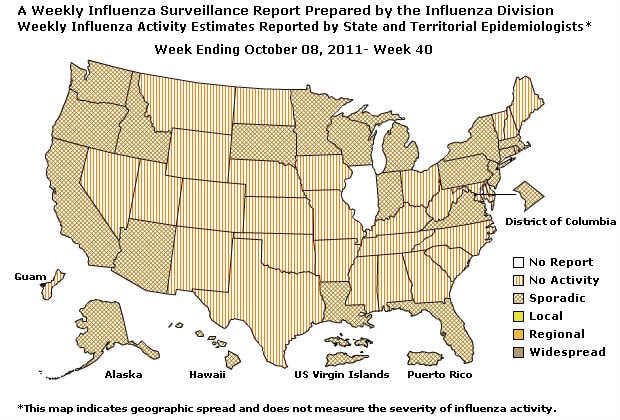
Flu Activity data in XML Format | View Full Screen
Additional National and International Influenza Surveillance Information
U.S. State and local influenza surveillance: Click on a jurisdiction below to access the latest local influenza information.
Distribute Project: Additional information on the Distribute syndromic surveillance project, developed and piloted by the International Society for Disease Surveillance (ISDS) now working in collaboration with CDC, to enhance and support Emergency Department (ED) surveillance, is available at http://isdsdistribute.org/
Google Flu Trends: Google Flu Trends uses aggregated Google search data in a model created in collaboration with CDC to estimate influenza activity in the United States. For more information and activity estimates from the U.S. and worldwide, see http://www.google.org/flutrends/
Europe: for the most recent influenza surveillance information from Europe, please see WHO/Europe at http://www.euroflu.org/index.php and visit the European Centre for Disease Prevention and Control at http://ecdc.europa.eu/en/publications/surveillance_reports/influenza/Pages/weekly_influenza_surveillance_overview.aspx
Public Health Agency of Canada: The most up-to-date influenza information from Canada is available at http://www.phac-aspc.gc.ca/fluwatch/
World Health Organization FluNet: Additional influenza surveillance information from participating WHO member nations is available at http://gamapserver.who.int/GlobalAtlas/home.asp
--------------------------------------------------------------------------------
A description of surveillance methods is available at: http://www.cy118119.com/flu/weekly/overview.htm
